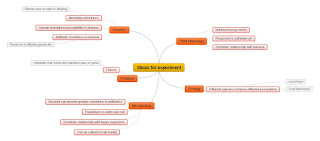Mind Mapping is a technique for visually organizing thoughts and ideas, and its usefulness in the classroom is only growing as we transition into a more visual and technological society. I originally encountered the idea of "mind mapping" when I first learned of the work of Tony Buzan, an educational consultant. Having read several articles by and about Buzan and mind mapping, I became intrigued by the concept. Making a mind map begins with a central topic and expands into a web of branching subtopics and ideas. It is an obvious and useful tool for brainstorming ideas, planning projects and events, and managing notes. Recently, I encountered MindMaple - a company committed to developing helpful and accessible mind-mapping software.
Mind mapping is an exciting educational tool because it promotes creativity and innovative thinking in ways other information techniques do not. And, as I've long argued, creativity and innovation is the key to American success. I've also noted the importance of using the brain's natural capacity for making connections to process and make sense of new information. Thus, it's worth talking about what MindMaple does and how mind mapping can be useful in the classroom and how it offers benefits that other information technologies do not.
For example, consider students in a high school biology class who are asked to design an experiment to answer a scientific question of their choice. Ideally, the assignment provides students a way to engage with course material, asking difficult and interesting questions that perhaps haven't been asked before. How can we encourage to interact with knowledge in a dynamic way, especially in today's world of standardized testing and rigid curricula. Mind mapping - and associated educational software - can help inspire minds and keep kids engaged. The mind map begins with the general topics covered in class ...
... and proceeds to expand these ideas into more specific concepts and related details. The branched structure of the mind map makes it an excellent tool for categorizing information.
What mind mapping offers uniquely is the opportunity to make connections between these various branches and concepts. After expanding these biology topics, students begin to notice connections between some of them - micro-organisms provide a good system for studying genetics and selection/fitness, and are also an integral part of the ecosystem. The mind map illustrates these connections with arrows and creates new topics for experiment ideas.
One of the greatest benefits of mind mapping is flexibility. Reorganizing the elements of the map is as simple as clicking and dragging. There's space for continued development in every region of the map, allowing your brain to see connections between different map branches, and develop those connections into creative ideas. Ultimately, it can be a pretty useful tool, and MindMaple software is worth checking out.
MindMaple, Inc. are the makers of MindMaple software. These maps were made using MindMaple Lite, a free software available from www.mindmaple.com
NOTE: This entry is a Guest Post sponsored by MindMaple, Inc.



1 comment:
Have you tried out Mind Vector - A popular Mind mapping App which quite similar features along with great UI design. Btw, you have explain really a nice app which I used before.
Post a Comment